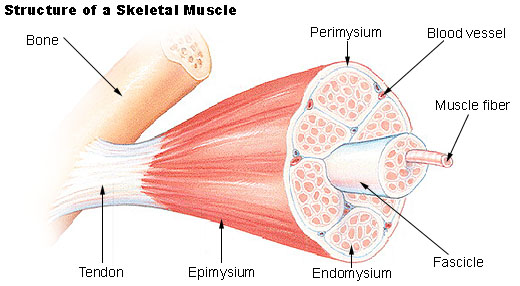Hello all, we are back with part 2. There has barely been enough time to digest part 1 but we wanted to keep the story line sailing smoothly so here it is. In this post, wet will be addressing muscle injury, recovery and repair.
Muscle tissue is a very active tissue – that it has a high level of energy because of the ample blood supply and nutrients it receives. In practical terms it means 2 important things: muscles GROW and HEAL QUICKLY, in comparison to other tissues. That is why when people start exercising and weight training, they note rapid growth in muscle mass and muscle conditioning. Muscle requires a lot of energy to be maintained, which is why you see all those muscle bound guys in the gym eating constantly! That is also why weight training should be incorporated into weight loss regimes, as at rest, muscle needs more energy to maintain itself than fat.
On the other hand, if muscles are not used constantly and/or fed adequately, they waste away, and waste away at an alarming rate. An example is immobilisation after surgery – A leg in a cast for six weeks results in a decrease of around 20% of the quadriceps muscle. Within hours, the metabolism of the muscles decreases, they begin to shorten and stiffen, so you can imagine how after just 6 weeks there is a significant decreases in muscles size, strength and length.
Those who go to the gym or exercise regularly will know that strength training (low reps, high weight) leads to an increase in muscle mass and size and that endurance training (high reps, low weight) increases the ability for sustained effort. However, an interesting bit of research we first came across in Louis Gifford’s Aches and Pains:
- Young people were asked to do 10 reps, twice a day, three times a week for 8 weeks of bicep contractions. They pushed with only 2 thirds of their force. After 8 weeks their ‘trained’ arm increased strength by 25%. Interestingly however, their ‘UNTRAINED’ ARM also INCREASED in strength by 15%. Suggesting there was a change in the nervous system that was contributing to this change in the ‘untrained’ arm.
- After repeating the training, they found that in the first 2 weeks,80% of the strength change in the trained arm was achieved by changes in the nervous system and muscle activation (this basically means that your muscle is not getting bigger, but is getting better at using more of the muscle – essentially becoming more efficient). The remaining 20% was due to changes in the muscle itself. However, after 8 weeks, 95% strength of the strength was due to changes in the muscle and only 5% due to changes in the nervous system.
The above studies are very useful for those who are immobilised as it shows that if you keep the other muscles of the body strong and active, you may be able to slow down the wasting and increase the recovery times of the immobilised area.
Finally, in another study, and a little off topic, groups of people who did exercises to strengthen the muscles of their little finger. The group that did the strengthening exercises increased in strength by 40% over 4 weeks but another group IMAGINED doing the exercises and increased their strength by 22%! Maybe we shouldn’t have mentioned that, otherwise people will never take advice to get up and moving!
Muscle Repair
Inital repair in muscle injury is done by weak disorganised fibres called collagen III, which are gradually replaced by collagen I, which is much stronger. It is therefore important to NOT stretch the injury or wound initially and slowly incorporate gentle stretches.
Research shows that taking it easy at the very beginning (a few days max) with muscle injuries is a good thing (it is important though that it is only for a very short period), as moving after a few days rest leads to:
- Better aligning of the new muscle fibres
- A faster decrease in surrounding blood and inflammation
- Better organised regeneration of the muscle
- Faster increase in strength of the muscle
Small Tears – Also known as strains lose power initially after injury, which is rather obvious. Inflammation lasts up to 4 days (Remember to ICE). Recovery begins 24-48 hours after injury and by day 7 power has returned to over 75% of the original. Muscle fibre regeneration is complete by 10- 14 days.
Large/Complete Tears – 50% muscle strength returns by 12 weeks and the ability to contract the muscle is about 80% of the original.
It is vitally important to have an idea of the recovery process as the times of recovery vary from weeks to months, which results in different treatment and management plans. However, one factor they all have in common is the old adage: USE IT, OR LOSE IT. Muscles, Ligaments and Tendons need to have loads put through them constantly to remain healthy. They weaken and waste away relatively quickly when unused for long periods. The common message to take away from all our blog posts is: KEEP ACTIVE AS MUCH AS POSSIBLE.
The importance of activity, any activity is better than no activity at all. Inactivity is the scourge of western lifestyle and ill health. Muscle is remarkable in its ability to adapt, as illustrated above and gives us all hope, no matter where we are in terms of our health, that we can always change our circumstances even if we begin by just doing 5 minutes more than we did yesterday.
Have a good week from all of us here at West 12 Health, West London. Hasta luego!
Follow us on Twitter: @West12Health
Follow us on Facebook: www.facebook.com/west12healthcentre
Follow us on WordPress: www.west12healthcentresite.wordpress.com



